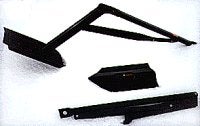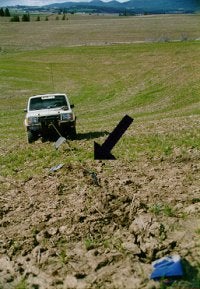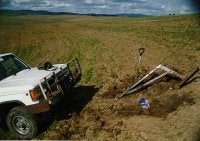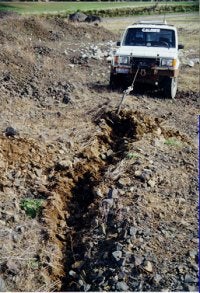
Unlike climbers, four wheelers have been slow to develop means of creating their own anchor points. Winching can be inefficient and frustrating because it typically relies on trees, rocks, or other vehicles as anchors. An ideal anchor point would be directly in the path of desired travel, but unless there is a lead vehicle (which could more easily use a pull strap), the path itself is often devoid of anchors. Off-line pulls, complex pulley systems, and buried tires are just a few examples of the unsavory, time consuming, and dangerous consequences that are caused by inadequate anchors. Enter the concept of the Pull-Pal, a self-burrowing anchor anchor that can be located precisely where needed, rather than where landscape features allow.
History
In the early '70s, Jan Gremillion's father enjoyed four-wheeling in the sands of Blyth, CA. It was a fateful and frustrating day that inspired the Pull Pal. Seriously stuck in the sand, with no good anchor, her father spent two hours walking to find help …and considering ideas for an anchor. He married his four-wheeling needs with his childhood experience with farm plows. The original Pull Pal resides with Jan and her husband Pat, a reminder of the Pull Pal's enduring design. The Pull Pal's design has gone through numerous design refinements spread over a quarter century of testing.

Finish quality is excellent, and the Pull-Pal comes in two sizes:
- Model RW 9000, recommended for all vehicles up to 9000 pounds (tested, here). Unit weighs 30 pounds. Size is 45 inches long when folded.
- Model RW 6000, recommended for Samurai-sized vehicles. Unit weighs 24 pounds. Size is 32 inches long when folded.
Testing
Camel Trophy teams, as well as the team that made the first winter ascent of Mt. Washington, give impressive testimonials for the Pull-Pal. These groups encountered predominantly mud or snow/ice terrain. This report will be updated as testing continues, as we test the anchor in a variety of terrain, and publish specific details about how the Pull-Pal performed. The test vehicle, unless otherwise noted, is Project WomBAT, a 4800lb '89 Trooper with a Ramsey REP6000 winch.Loose Dirt
In the Palouse region of eastern Idaho and western Washington state, wheat is king. The landscape, dominated by agriculture, makes drivers feel as though they are moving through a giant mogul field. The round hills rise a hundred feet high, and span a few hundred yards across. The resulting steep slopes require special hydraulically-suspended combines to harvest the crops. Those same slopes offer a vast testing ground for off-road products.My friend, Jeff Nelson, and three partners, farm 4,000 acres of the Palouse. Jeff knows soil, so based on my description of the test I wanted to run, he took me to a bowl with slopes of over 25 percent. The field had been tilled to 18 inches deep as part of testing on a new implement.


Using a set of storage covers made from vinyl truck tarp material (see future BYOB article), the entire Pull-Pal fit easily into the back of the Trooper (for continued use, a brush bar mount was fabricated). In response to the Pull Pal's widespread acceptance, Garvin Industries (619-440-7415) has even developed a bracket for mounting the anchor on one of their roof racks.
Loose Rubble

Our results were less positive in this unyielding terrain. The Pull Pal relies upon finding an appropriate amount of resistance. Either too much or too little resistance means the anchor can't do its job. In the quarry's rubble, when set into various sizes of starter holes, the Pull-Pal either failed to find a hold, or began to dig in, only to level out and dig a shallow trough as the tip apparently ran into dense rock that couldn't be penetrated. Repeated tests yielded the same results. In this terrain, either the surface was too hard and could not be penetrated, or it was so loose that the unit was pulled through the upper foot or so of ground. We speculate that a significant hole, maybe 18 inches deep, would have to be dug to reach a point where the anchor could both penetrate for a hold and encounter significant resistance once the spade had set in.
Rocky Hardpan
After disappointment in the quarry's moonscape, we tested the Pull-Pal in rocky hardpan that did not exhibit the extremes found in the quarry. The dry hardpan ground was made up of gravel mixed with heavy clay soils and had been compacted by earthmoving equipment. We made a small divot, about the size of a grapefruit, in a small slope that angled away from the truck. This was more than adequate for the spade to take hold. As the picture shows, complete spade penetration was unnecessary to give sufficient resistance for the Ramsey to overcome the Trooper's 4.55 gears, parking brake, and a large rock wheel block.Conclusions
The Pull Pal has been steadily gaining acceptance within off-roading circles as THE anchoring device to carry. Not surprisingly, global military powers have also begun to recognize the device's capabilities, purchasing numerous units for combat extrication.The Pull-Pal clearly can provide a viable anchor where none exists, but it has other benefits which are easier to overlook. This anchor can decrease wear and tear by allowing you to select your choice of anchoring locations. This allows you to winch from the first layer of cable, making the most of your winch's mechanical leverage and increasing the line uptake speed. You will also be able to avoid most angled pulls. Though the Camel Trophy testimonials for the Pull-Pal are impressive, for most of us, reducing the strains on personalities and equipment could be the biggest selling point.
We tested in a variety of soil types and proved the Pull-Pal's outstanding anchoring effectiveness. Even in very loose soils, this anchor is easily set by one person, creates substantial resistance, and requires relatively little effort to extricate.
The Pull-Pal harnesses your winch's power and dives down until it meets enough resistance to counter the drag of your vehicle. Even when the Pull-Pal dives deeply, extracting it is not difficult. Not many will encounter soil (not sand) that is looser than we tested. If you do, you can expect the Pull-Pal to dive down until it meets enough resistance to counter the drag of your vehicle.
- Testing in hardpan gravel-clay revealed that the anchor creates sufficient resistance after having only buried a portion of the spade.
- In loose rock with soil filler, we found the Pull Pal dug long furrows without setting, searching in vain for resistance. This is especially problematic if a compacted rock layer lies below the loose rock layer, because the anchor can't always find purchase in the hidden rock layer.
How would a stuck enthusiast fare in similar featureless landscapes without the Pull-Pal? Let's just say that removing, burying, and recovering your spare tire, especially in hardpan, would have been a LOT better work out…if that is why you going four wheeling!
The makers of the Pull-Pal also produce the Premier Power Underhood Welding Syst em. Click here to see the Off-Road.com Premier Power Welder Review.
P.O. Box 639, Carbondale, CO 81623
(800) 541-1817
tech/phone/fax (970)-963-8875
For more information, email pullpal@rof.net.


 Your Privacy Choices
Your Privacy Choices